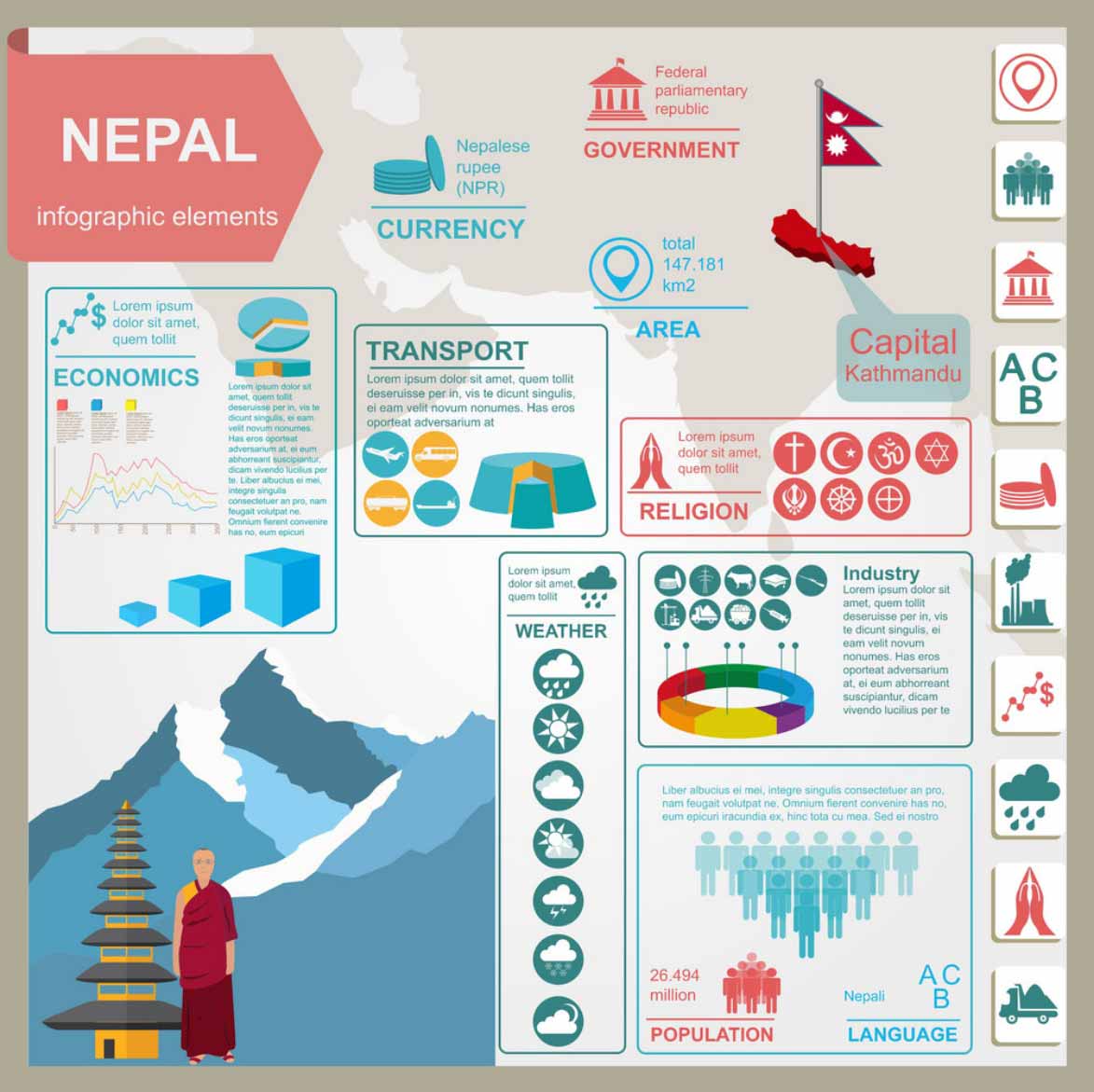Karlani Province : A Data Overview
A comprehensive data journal with an objective to
make data free for everyone collected and
compiled in one single address. Explore with us.
Karnali Province

Geography
Karnali province lies between 80058’58” & 83040’57” East longitude and 28010’7″ & 30026’50” North latitude. It has an area of 30,211 sq.km i.e 21.6% of the total area of the country. Out of which 38% land is covered by forest. Including 12.8% of graze land and 3.2% bush area total forest area of Karnali Province is 41%. It is bordered by Lumbini Province in the south, China in the north, Sudurpaschim Province in the west and Lumbini Province and Gandaki Province in the east. The Province is stretched 265 km east-west and 250 km north-south.
Topographically, the province is divided into four main regions starting from the the high Himalayan Region, Mahabharat region, mid mountains, valleys, and Chure in the south. The highest peak point of the Province is Churen Himal (7348 m). Surkhet valley is the capital of the Karnali Province. The valley is 9 km in length and 6 km breadth. Limi valley in Humla district of the province lies at an altitude above 4000 meter.
Apart from the topographical divisions, administratively there are 10 Districts. As per the new constitutional provision there are 79 local governments composed of 25 municipalities and 54 rural-municipalities with 718 wards.
Climate
Karnali province has climatic variations, which is associated with the diverse nature of its topography and altitude. Climatic zone of Karnali province starts from High Himal in the north, above 7000m with tundra and arctic climate to Chure region in the south with sub-tropical climatic zone. The average annual precipitation of the Province is 1479mm. According to studies Karnali Province is facing decrease in annual precipitation by 4.91mm yearly. Average annual temperature of the province is 26.10c. The maximum and minimum temperature of the Province is increasing yearly by 0.05 (maximum) and 0.01 (minimum).
Karnali Province is named after the longest river Karnali, measuring 507 km. Karnali River has many sub basins namely Bheri, Mugu Karnali, Tila, Lodi, Dojam, Seti, Babai, Rapti etc. 95% of the Karnali River flows in Nepal, remaining parts are in India and China. Karnali Province is rich in Lakes and Ponds. There are 936 lakes in the province, among which 429 lakes are above 5000 m including the largest lake Rara and deepest Lake Phoksundo of the country.
Social and Cultural Diversity
Among various spoken languages in the Province Nepali is spoken by 94.90 percent population. Sinja Valley, the place of origin of Nepali Language lies in Jumla district of the Province. Other major language spoken in the Province are Magar 2.46%, Tharu 0.44%, Bhote/Lama 0.75%, Kham 0.34%, Gurung 0.28%, Sherpa 0.19% and others 0.65%. The largest ethnic group in the Province is Chhetri (41.9%). Similarly, there are 15.8% Kami, 10.9% Magar, 10.3% Thakuri, Brahmin (8.4%), Damai (4%), Sarki 2.6%), Sanyasi (1.7%) and others 1.6%. Majority of population are Hindu (95.14%) in the Province predominantly followed by Buddhist (3.19%), Christian (1.36%), Muslim (0.18%) and others (0.1%). Out of the total population of the province (1570418) 49.31% of the population are residing in the urban area.
Economy
As per Economic Survey (2019/20), Karnali Province contributes 4% to national GDP and it is estimated to have a growth rate of 3.6% in the fiscal year 2019/20.
There are 169 commercial banks, 20 development banks, 4 finance companies and 186 Microfinance companies in the Province, which is 3.9 percent of the total banking and commercial institutions in the country. Similarly, there are 139 life and 45 non life insurance companies and their branches in the province.
Agriculture and forest is the mainstay of province economy, providing a livelihood for three-fourths of the population and accounting 32.9% of GDP. Industrial activity in the province accounts very low and it shares only 13.8% of GDP, while service sector has a share of 53.3% in provincial GDP. Productivity of paddy in the province is 3.46 MT per ha, which is below the national average productivity of 3.8 MT per ha.
Out of the total paddy production in the country Karnali Province comprises 2.4%. Similarly 8.1% of Wheat, 8.2% Maize, 6.3% Buckwheat and 43.7% Barley is produced in the province.
According to Ministry of Agriculture and Livestock development in the year 2077 Karnali Province has Paddy plantation in 98.53% of the Paddy field in the Province.
There are 17063 small & cottage and mini industries in the Province registered under department of industry. Similarly, there are 2670 companies registered under company act in the province.
Karnali Province has immense potential of hydropower. But it has not seen a considerable growth in electrification till date. According to Nepal Electricity Authority report only 34.75% household in the province are electrified. Total number of electricity consumers in the province is 94662, consuming 46525 MWh of energy annually. According to NEA, Distribution and Consumer Service Directorate loss of electricity in the province is 15.66% for the year 2076/77. Out of the total loss in distribution Rukum (west) provincial office, contributes the highest loss percentage of 23.96.
2725 km of road is constructed in the Province. Out of total road constructed only 79 km is blacktopped, 193 km road is graveled and 2453 km road is earthern.
There are 3167 schools in the province with 537457 students including 277186 girls and 260271 boys. All together there are 11840 teachers working in various levels of schools.
Province Overview
| Indicators | Value |
|---|---|
| Geography | |
| Area (sq.km) | 28996 |
| Capital | Surkhet |
| Administrative Division | |
| Districts | 9 |
| Metropolitan City | 0 |
| Sub-Metropolitan City | 0 |
| Municipality | 25 |
| Gaun Palika | 54 |
| Total No. of Wards | 718 |
| Voters (2074) | |
| Total | 783504 |
| Male | 394424 |
| Female | 389078 |
| TG | 2 |
| Constituenties | 12 |
| Demography | |
| Population (2011) | 1570418 |
| Male | 767923 |
| Female | 802495 |
| Sex Ratio (M/F) | 98.5 |
| Total Household | 298359 |
| Average Household Size | 5.4 |
| Population Density (persons/sq.km) | 79.11 |
| Population by Type of Local Unit | |
| Metropolitan City | 0 |
| Sub-Metropolitan City | 0 |
| Municipality | 774316 |
| Gaun Palika | 780926 |
| note: percentage as of total population of the province | |
| Under 14 Population (%) | |
| Population 15-59 yrs (%) | |
| Elderly Population 60+ (%) | |
| Annual Growth Rate (%) | |
| Household by Ownership of House (2011) | |
| Own | 252625 |
| Rented | 11986 |
| Household using wood/firewood as type of cooking fuel | 251901 |
| Household using Electricity as type of cooking fuel | 945 |
| Household with access to safe drinking water* | 161080 |
| Household with access to Toilet Facilities | 140803 |
| Household without access to Toilet Facilities | 125057 |
| Household with access to Internet | 1240 |
| Household with access to Mobile Phone | 115555 |
| Household with access to Radio | 136680 |
| Household with access to Television | 24111 |
| Household with access to Electricity for lighting | 60680 |
| Household by Type of Foundation of House | |
| Household with Mud bonded bricks/stone as foundation of house | 235497 |
| Household with Cement bonded bricks/ stone as type of foundation of house | 6805 |
| RCC with pillar | 3860 |
| Wooden pillar | 18699 |
| Household with Female ownership in | |
| Both house & land | 12406 |
| Land only | 9365 |
| Neither house nor land | 244010 |
| Socio-Economic Indicators | |
| Literacy (%) (NMICS 2019) | |
| Total | |
| Male | |
| Female | |
| Number of Schools (Public) 2018/19 | |
| L_Basic | 2991 |
| U_Basic | 1123 |
| Basic | 3027 |
| Secondary | 580 |
| Higher Secondary | 241 |
| Number of Schools (Private) | |
| L_Basic | 144 |
| U_Basic | 90 |
| Basic | 144 |
| Secondary | 57 |
| Higher Secondary | 19 |
| Number of Students (Public) | |
| L_Basic | 285499 |
| U_Basic | 135309 |
| Basic | |
| Secondary | 74797 |
| Higher Secondary | 47599 |
| Number of Students (Private) | |
| L_Basic | 25732 |
| U_Basic | 9012 |
| Basic | |
| Secondary | 3327 |
| Higher Secondary | 941 |
| NER 2018/19 | |
| L-Basic | 97 |
| U_Basic | 89.9 |
| Basic | 93.4 |
| Secondary | 64.1 |
| Higher Secondary | 25 |
| Agriculture (FY 017/18) | |
| Production of Major Cereal Crops (MT)2017/18 | |
| Paddy | 131746 |
| Maize | 214626 |
| Wheat | 160213 |
| Production of Major Cash Crops (MT) 2017/18 | |
| Oil Seed | 6510 |
| Potato | 141168 |
| Sugarcane | 68 |
| Production of Pulses | 13327 |
| Production of Spices | 56000 |
| Production of Vegetables (MT) | 136645 |
| Productio of Milk (MT) | 113374 |
| Production Eggs in number (000) | 26277 |
| Production of Fish (Kg) | 78456.63 |
| Meat Production (MT) | 21631 |
| Production of Wool (MT) | 214967 |
| Production of Fruits (MT) | |
| Citrus Fruits# | 22387 |
| Winter Fruits** | 22799 |
| Summer Fruits*** | 13725 |
| Annual Sales of Chemical Fertilizers (017/18) | 3900.5 |
| Health Service**** | |
| Number of Hospitals | 12 |
| Primary health care center (PHCC) | 13 |
| Health Care Centers | 336 |
| Female Health Care Volunteer | 4102 |
| Road Connectivity | |
| Total Road Length## (Km) | 1343.43 |
| Population Influenced per Km of Road | 10939 |
| Road Density (Km/100 sq.km) | 70 |
Local Governments in Data
| Municipalities | Districts | Area (sq km) | Population | Schools | Hospitals | Details |
|---|---|---|---|---|---|---|
| Aathabees Municipality | Dailekh | 168 | 29227 | 60 | - | View More |
| Chamunda Bindrasaini Municipality | Dailekh | 90.6 | 26149 | 54 | - | |
| Dullu Municipality | Dailekh | 156.77 | 41540 | 56 | 1 | |
| Narayan Municipality | Dailekh | 110.63 | 27037 | 49 | 1 | |
| Thuli Bheri Municipality | Dolpa | 421.34 | 8370 | 24 | 1 | |
| Tripurasundari Municipality | Dolpa | 393.54 | 10104 | 32 | - | |
| Bheri Malika Municipality | Jajarkot | 219.77 | 33515 | 62 | 1 | |
| Chhedagad Municipality | Jajarkot | 284.2 | 35295 | 104 | - | |
| Tribeni Nalagad Municipality | Jajarkot | 387.44 | 25590 | 71 | - | |
| Chandannath Municipality | Jumla | 102.03 | 19047 | 22 | 1 | |
| Khandachakra Municipality | Kalikot | 133.29 | 20288 | 41 | 1 | |
| Raskot Municipality | Kalikot | 59.73 | 16272 | 30 | - | |
| Tilagufa Municipality | Kalikot | 262.56 | 15766 | 38 | - | |
| Chhayanath Rara Municipality | Mugu | 480.67 | 20082 | 47 | 1 | |
| Aathbiskot Municipality | Rukum West | 560.34 | 33601 | 64 | - | |
| Chaurjahari Municipality | Rukum West | 107.38 | 27438 | 45 | - | |
| Musikot Municipality | Rukum West | 136.06 | 32939 | 69 | 1 | |
| Bagachour Municipality | Salyan | 163.14 | 34118 | 73 | - | |
| Banagad Kupinde Municipality | Salyan | 338.21 | 36052 | 74 | - | |
| Sharada Municipality | Salyan | 198.34 | 33730 | 60 | 1 | |
| Bheriganga Municipality | Surkhet | 256.2 | 41407 | 60 | - | |
| Birendranagar Municipality | Surkhet | 245.06 | 100458 | 120 | 1 | |
| Lekbeshi Municipality | Surkhet | 180.92 | 30295 | 43 | - | |
| Panchapuri Municipality | Surkhet | 329.9 | 32231 | 60 | - |
Human Development Index (HDI)
Life Expectancy Rate (years)
Literacy Rate (%)
Per Capita Income (USD)
Popn Under Absolute Poverty (%)
Sector-wise Data Overview of Karnali Province
Fast Facts of Karnali Province
Nepal Outlook compiles key indicators based upon recently updated research and survey documents published and endorsed by Central Bureau of Statistics, Nepal Government in a most easiest and clear format.
We also help you get any data, report and research materials upon request at a minimum service charge.
1570418
Total Population
25.8%
Household with Access to Internet
298359
Total Household
44.9%
Popn with Access to Electricity
774316
Urban Population
44.3%
Child Marriage Before 18 (women)
118511
Arable Land (ha)
78.7%
Ownership of Mobile Phone
9.7%
Unemployment
108205
Electricity Consumers
84.4%
Birth Registration
2725
Local Roads Network (km)
Data Leader, 21 Years in a Row
Focusing on various sectors related to development of the country, our team has been actively involved in disseminating information about districts since 1999 AD through various editions of Data Profile’s namely District Development Profile of Nepal (2001), District Demographic Profile of Nepal (2002), District Development Profile of Nepal (2004), National Policies of Nepal, Development Profile of Nepal (2008) & Energy Outlook of Nepal (2011).


The Right Choice
Share us your contact details to discuss on how we can work together on your research and study projects. We come and discuss your problem statements and provide expert consulting to derive right process and solution for your business.
